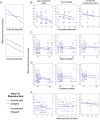Accelerated reproduction is not an adaptive response to early-life adversity in wild baboons
- PMID: 32958642
- PMCID: PMC7547275
- DOI: 10.1073/pnas.2004018117
Accelerated reproduction is not an adaptive response to early-life adversity in wild baboons
Abstract
In humans and other long-lived species, harsh conditions in early life often lead to profound differences in adult life expectancy. In response, natural selection is expected to accelerate the timing and pace of reproduction in individuals who experience some forms of early-life adversity. However, the adaptive benefits of reproductive acceleration following early adversity remain untested. Here, we test a recent version of this theory, the internal predictive adaptive response (iPAR) model, by assessing whether accelerating reproduction following early-life adversity leads to higher lifetime reproductive success. We do so by leveraging 48 y of continuous, individual-based data from wild female baboons in the Amboseli ecosystem in Kenya, including prospective, longitudinal data on multiple sources of nutritional and psychosocial adversity in early life; reproductive pace; and lifetime reproductive success. We find that while early-life adversity led to dramatically shorter lifespans, individuals who experienced early adversity did not accelerate their reproduction compared with those who did not experience early adversity. Further, while accelerated reproduction predicted increased lifetime reproductive success overall, these benefits were not specific to females who experienced early-life adversity. Instead, females only benefited from reproductive acceleration if they also led long lives. Our results call into question the theory that accelerated reproduction is an adaptive response to both nutritional and psychosocial sources of early-life adversity in baboons and other long-lived species.
Keywords: adaptive developmental plasticity; early-life adversity; fitness; internal predictive adaptive response model; life history.
Copyright © 2020 the Author(s). Published by PNAS.
Conflict of interest statement
The authors declare no competing interest.
Figures




Similar articles
-
Cumulative early life adversity predicts longevity in wild baboons.Nat Commun. 2016 Apr 19;7:11181. doi: 10.1038/ncomms11181. Nat Commun. 2016. PMID: 27091302 Free PMC article.
-
High social status males experience accelerated epigenetic aging in wild baboons.Elife. 2021 Apr 6;10:e66128. doi: 10.7554/eLife.66128. Elife. 2021. PMID: 33821798 Free PMC article.
-
Social bonds do not mediate the relationship between early adversity and adult glucocorticoids in wild baboons.Proc Natl Acad Sci U S A. 2020 Aug 18;117(33):20052-20062. doi: 10.1073/pnas.2004524117. Epub 2020 Aug 3. Proc Natl Acad Sci U S A. 2020. PMID: 32747546 Free PMC article.
-
Social and early life determinants of survival from cradle to grave: A case study in wild baboons.Neurosci Biobehav Rev. 2023 Sep;152:105282. doi: 10.1016/j.neubiorev.2023.105282. Epub 2023 Jun 13. Neurosci Biobehav Rev. 2023. PMID: 37321362 Free PMC article. Review.
-
Puberty and dispersal in a wild primate population.Horm Behav. 2013 Jul;64(2):240-9. doi: 10.1016/j.yhbeh.2013.02.014. Horm Behav. 2013. PMID: 23998668 Free PMC article. Review.
Cited by
-
DNA methylation signatures of early life adversity are exposure-dependent in wild baboons.bioRxiv [Preprint]. 2023 Jun 5:2023.06.05.542485. doi: 10.1101/2023.06.05.542485. bioRxiv. 2023. Update in: Proc Natl Acad Sci U S A. 2024 Mar 12;121(11):e2309469121. doi: 10.1073/pnas.2309469121. PMID: 37333311 Free PMC article. Updated. Preprint.
-
Male-mediated early maturation unlikely to evolve via adaptive evolution.Anim Behav. 2024 Aug;214:219-240. doi: 10.1016/j.anbehav.2024.06.002. Epub 2024 Jul 9. Anim Behav. 2024. PMID: 39035706
-
The Goldilocks effect: female geladas in mid-sized groups have higher fitness.Proc Biol Sci. 2021 Jun 9;288(1952):20210820. doi: 10.1098/rspb.2021.0820. Epub 2021 Jun 2. Proc Biol Sci. 2021. PMID: 34074124 Free PMC article.
-
Social drivers of maturation age in female geladas.Behav Ecol. 2022 Apr 13;33(3):654-664. doi: 10.1093/beheco/arac028. eCollection 2022 May-Jun. Behav Ecol. 2022. PMID: 35600996 Free PMC article.
-
Early life adversity has long-term effects on sociality and interaction style in female baboons.Proc Biol Sci. 2022 Feb 9;289(1968):20212244. doi: 10.1098/rspb.2021.2244. Epub 2022 Feb 2. Proc Biol Sci. 2022. PMID: 35105243 Free PMC article.
References
-
- Felitti V. J. et al. ., Relationship of childhood abuse and household dysfunction to many of the leading causes of death in adults. The Adverse Childhood Experiences (ACE) Study. Am. J. Prev. Med. 14, 245–258 (1998). - PubMed
-
- Lynch J., Smith G. D., A life course approach to chronic disease epidemiology. Annu. Rev. Public Health 26, 1–35 (2005). - PubMed
-
- O’Rand A. M., Hamil-Luker J., Processes of cumulative adversity: Childhood disadvantage and increased risk of heart attack across the life course. J. Gerontol. B Psychol. Sci. Soc. Sci. 60, 117–124 (2005). - PubMed
-
- Roseboom T., de Rooij S., Painter R., The Dutch famine and its long-term consequences for adult health. Early Hum. Dev. 82, 485–491 (2006). - PubMed
Publication types
MeSH terms
Associated data
Grants and funding
LinkOut - more resources
Full Text Sources
Other Literature Sources
Miscellaneous

